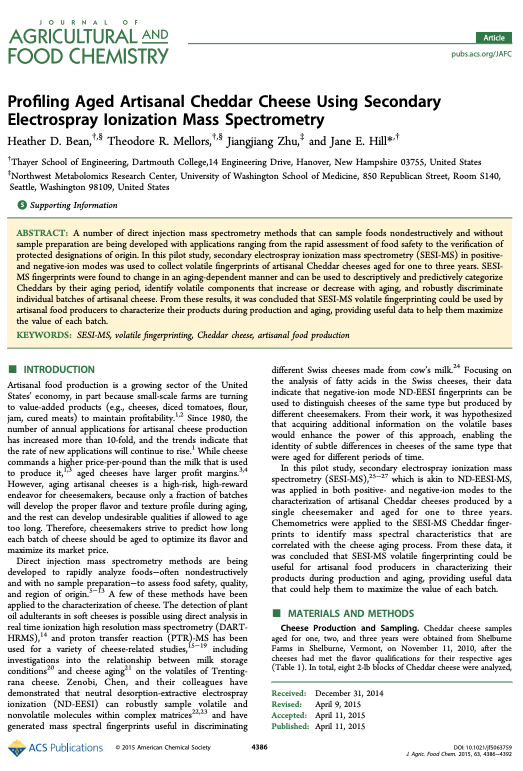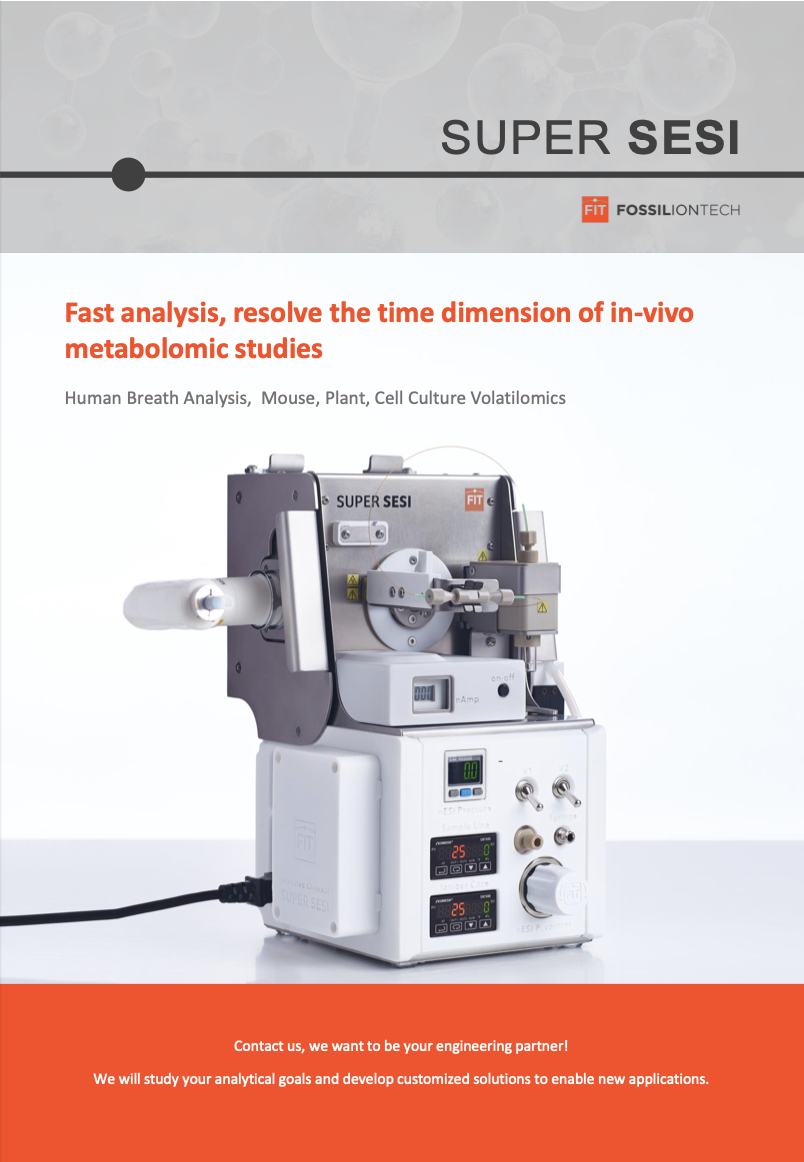
Food & Aroma
Non-destructive, Real-time and Non sample preparation Food & Aroma analysis with SUPER SESI-HRMS
Flavor and Aroma Profiling
Labile and sulfur compounds
High-throughput applications
Nose-space analysis to quantitate sensory experience

Food & Aroma monitoring with SUPER SESI-HRMS technology, 6 reasons:
1- Real-time Compound identification
Of the peaks detected using SUPER SESI X-Orbitrap Exploris 120, several compounds were identified in real-time by combining the molecular formula and previous databases for chocolate flavor built by direct injection analysis.
2- Nose Space analysis
SUPER SESI-HRMS offers insights into how various molecules interact with the nasal cavity during breathing and ingestion, opening new perspectives to comprehend the complexities of sensory experiences related to taste and smell.
3- LABILE compound identification.
Utilizing SUPER SESI circumvents the issue of heat-induced degradation that may occur during measurements, enabling a more accurate analysis of volatile compounds such as allicin.
Varying the temperature at the intake line, ionizer core and intake capillary had a huge impact on the composition and intensity of measured volatiles.
“Allicin is the major active component in crushed garlic, but its reactivity and heat instability cause challenges in the analysis of gas phase samples. Volatile compounds are often analysed by GC–MS where temperatures >100 ◦C are commonly used. These conditions do not necessarily reveal the natural volatilome because compounds not volatile at lower temperatures might be volatilised at higher operating temperatures but with artefact production likely with heat -labile compounds, such as allicin.”
Seeing the smell of garlic: Detection of gas phase volatiles from crushed garlic (Allium sativum), onion (Allium cepa), ramsons (Allium ursinum) and human garlic breath using SESI-Orbitrap MS; Food Chemistry, Alan J.Slusarenko et al.
4- SUPER SESI-HRMS enables to measure the volatilome with a temporal resolution of 2 seconds
This system does not rely on analyte separation, so the time between molecules entering the SESI and reaching the high vacuum in the Orbitrap is only about 2 seconds, reducing degradation by fragmentation and bimolecular processes. Also, the ionisation is very soft and can be achieved at atmospheric pressure and low temperature.
SESI-Orbitrap MS allows real-time analysis because the need for chromatographic separation is bypassed, and full-MS scans can be recorded every 0.3 s.
5- HEADSPACE ANALYSIS WITHOUT SAMPLE PREPARATION.
SUPER SESI-HRMS fingerprints provides a unique capability to distinguish between the volatilomes of different food sources. This differentiation adds a new dimension to understanding and comparing the composition and aroma characteristics of various food products.
”The data suggest that SESI-MS can be employed to descriptively and predictively categorize artisanal Cheddar cheeses by their aging period, measure batch-to-batch differences in volatile profiles, and identify volatile components that are correlated with aging. Because SESI-MS is a rapid, nondestructive method for volatiles analysis, it is proposed that this technology is well suited for quality analysis in food production and could be extended to the production of other artisanal aged products with complex flavor profiles, such as wines, spirits, and cured meats.“
Profiling Aged Artisanal Cheddar Cheese Using Secondary Electrospray Ionization Mass Spectrometry; Agricultural and food chemistry, Jane E. Hill et al.
SESI-MS fingerprints from one-, two-, and three-year-aged Shelburne Farms Cheddar cheese in positive-ion mode (left column) and negative-ion mode (right column). The spectra are averages of 18 replicates for 1- and 2-year-aged Cheddar, and 12 replicates for 3-year-aged Cheddar, and normalized to the peak of greatest intensity in each spectrum.
6- Application versatility, Customizable and easy implementation:
The equipment required for SUPER SESI-HRMS is readily available and can be easily interfaced with commercial high-resolution mass spectrometers. The workflow is relatively easy to implement and allows for customization based on specific research requirements.
The data generated from SUPER SESI-HRMS is compatible with standard software for direct-injection mass spectrometry-based metabolomics, making it easy to analyze and interpret the results.
SUPER SESI-HRMS has diverse applications in animal research, including studying disease progression, evaluating treatment efficacy, and monitoring environmental exposures. It can also aid in the development of new diagnostic tools and therapies.
CUSTOMER SUCCESS
Dr. Prof. Renato Zenobi - ETH Zurich, Switzerland
“When SESI is combined with state-of-the-art mass spectrometers, low limits of detection (pptv) are achievable without any sample pre-concentration. We exploit this feature in our lab in a number of projects which require fast mass spectrometric analysis of vapors at trace concentrations.”
Dr. Prof. Patrik Španěl - J. Heyrovsky Institute of Physical Chemistry of the CAS, Prague, Czech Republic
“The SSX ion source is surely a masterpiece of state of the art engineering. Full understanding of the ion chemistry occurring between the ESI generated ions and VOC molecules inside will be an interesting challenge to tackle.”
Dr. Prof. Pablo Sinues - University Children’s Hospital Basel, University of Basel, Switzerland
“…SESI-HRMS breath testing may serve as a companion diagnostic approach to potentially minimize drug side effects and help to choose the seizure-specific treatment. Key advantages that make SESI-HRMS ideal for the hospital in – and outpatient setting include noninvasiveness and real-time results. […]This, along with the ability to predict serum concentration of drugs, allows us to propose a clinical decision-making workflow based on real-time breath analysis.”
Dr. Prof. Xue Li - Jinan University, Guangzhou, China.
“SESI-HRMS provides a robust way for online real-time monitoring of non-volatile drugs in exhaled breath.”
Prof. Dr. med. Malcolm Kohler - University Hospital Zurich (USZ), Switzerland.
“Real-time breath analysis by secondary electrospray-high resolutionmass spectrometry allows molecular profiling of exhaled breath, providing insights about on-going biochemical processes in COPD patients at risk for exacerbations.”
























